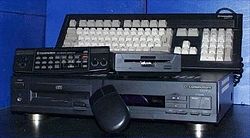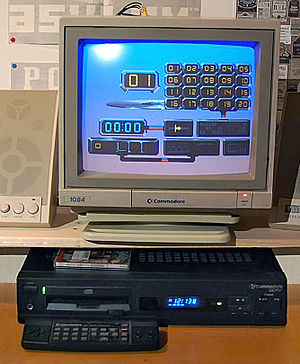- Commodore CDTV
-
"CDTV" redirects here. For the Chilean TV channel, see CDtv. For the Japanese music television show, see Count Down TV.
Commodore CDTV 
Manufacturer Commodore Generation Fourth generation Release date March 1991 Media CD-ROM Operating system AmigaOS 1.3 CPU Motorola 68000 @ 7 MHz Memory 1 MB The CDTV (for "Commodore Dynamic Total Vision") was a multimedia platform developed by Commodore International and launched in 1991. On a technological level it was essentially a Commodore Amiga 500 home computer in a Hi-Fi style case with a single-speed CD-ROM drive. Commodore marketed the machine as an all-in-one home multimedia appliance rather than a computer. As such, it targeted the same market as the Philips CD-i. Unfortunately for both Commodore and Philips, the expected market for multimedia appliances did not materialise, and neither machine met with any real commercial success. Though the CDTV was based entirely on Amiga hardware it was marketed strictly as a CDTV, with the Amiga name omitted from product branding.
The CDTV debuted in North America in March 1991 (CES, Las Vegas) and in the UK (World of Commodore 1991 at Earls Court, London).[1] It was advertised at £499 for the CDTV unit, remote control and two titles.[2] Commodore chose Amiga enthusiast magazines as its chief advertising channel, but the Amiga community on the whole avoided the CDTV in the expectation of an add-on CD-ROM drive for the Amiga, which eventually came in the form of the A570.
The CDTV was supplied with AmigaOS 1.3, rather than the more advanced and user-friendly 2.0 release that was launched at around the same time. Notably, the CDXL motion video format was primarily developed for the CDTV making it one of the earliest consumer systems to allow video playback from CD-ROM.
Though Commodore later developed an improved and cost-reduced CDTV-II it was never released.[3] Commodore eventually discontinued the CDTV in 1993 with the launch of the Amiga CD32, which used which again was substantially based on Amiga hardware (in this case the newer Amiga 1200) but explicitly targeted the games market.
Contents
Design
The CDTV was intended as a media appliance rather than a personal computer. As such, its housing had dimensions and styling compatible with most stereo components, and it came with an infrared remote control. Similarly, it was initially sold without keyboard and mouse (which could be added separately, and were later bundled with the machine). The CDTV was based on the same technology as earlier Amiga systems, but featured a single-speed CD-ROM drive and no floppy disk drive as standard.
Technical specifications
Attribute Specification Processor Motorola 68000 at 7.16 MHz (NTSC) or 7.09 MHz (PAL) RAM 1 MB Amiga Chip RAM (upgradable)
2 kB non-volatile RAMROM 256 kB Kickstart ROM
256 kB CDTV firmware ROMChipset Original Chip Set (OCS) or Enhanced Chip Set (ECS) Video 12-bit color palette (4096 colors)
Graphic modes with up to 32, 64 (EHB mode) or 4096 (HAM mode) on-screen colors:
- 320×200 to 320×400i (NTSC)
- 320×256 to 320×512i (PAL)
Graphic modes with up with up to 16 on-screen colors:
- 640×200 to 640×400i (NTSC)
- 640×256 to 640×512i (PAL)
Audio 4 × 8-bit PCM channels (2 stereo channels)
28 kHz maximum DMA sampling rate
Removable storage Single-speed CD-ROM drive (proprietary controller) Input/output ports Keyboard (5 pin mini-DIN)
Mouse (4 pin mini-DIN)
RS-232 serial port (DB-25M)
Centronics style parallel port (DB-25F)
Floppy disk drive port (DB-23F)
MIDI (In and Out)Audio/Video output Audio out (2 × RCA and 6.35 mm stereo jack)
Analog RGB video out (DB-23M)
RF audio/video out (RCA[a] or RF loop through[b])
Composite video out (RCA)[a][b]
S-Video out (4-pin mini-DIN)[a]
SCART audio/video out[c]Expansion slots Proprietary card slot by ITT-Cannon and Fujisoku from 8 to 1024 KB non-volatile memory cards
(1 MB addressing needs a hardware hack)
80-pin diagnostic slot
30-pin DMA expansion slot
Video slotOperating system AmigaOS 1.3 (Kickstart 1.3/Workbench 1.3) and CDTV firmware Physical dimensions 430 × 330 × 95 mm (W × D × H) Other Wireless infrared remote control/gamepad
Front panel with display and controls for CD playerNotes
Official upgrades
The CDTV was compatible with many existing Amiga peripherals. In addition, official CDTV peripherals and upgrades included:
- Wireless infrared mouse
- Wireless trackball
- Black styled keyboard
- SCSI controller providing both an internal and external SCSI connector for hard disk drives and other SCSI devices
- External black styled hard disk drive[4]
- External black styled floppy disk drive
- Proprietary memory cards with a capacity of 64 or 256 kB (CD1401/CD1405) allowing storage of game scores and progress[5]
- Genlocks for NTSC or PAL (CD 1300/CD1301) to overlay video signal with a secondary video source[6]
Versions
- CDTV: CDTV unit and remote control/gamepad
- Pro pack: CDTV unit, remote control/gamepad, keyboard, mouse and floppy disk drive, along with Almathera CDPD Public Domain software compilation on CD-ROM
Market competition
High-end A/V (primary market)
(multi-purpose audio/video systems)
- Philips' CD-i
- Pioneer's LaserActive
- The 3DO Company's 3DO Interactive Multiplayer
- Tandy Video Information System
Video gaming (secondary market)
- NEC PC Engine with Super CD-ROM expansion
- Nintendo's SNES
- Sega Mega Drive with CD-ROM expansion
- The 3DO Company's 3DO Interactive Multiplayer
See also
References
- ^ "The Commodore CDTV Information Center - www.cdtv.org.uk". http://www.cdtv.org.uk/1254.html.
- ^ "Amiga History Guide". http://www.amigahistory.co.uk/adverts/advert3.jpg.
- ^ "The Big Book of Amiga Hardware - Commodore CDTV-II". http://bboah.amiga-resistance.info/cgi-bin/showhardware_en.cgi?HARDID=34.
- ^ "The Commodore CDTV Information Center - www.cdtv.org.uk". http://www.cdtv.org.uk/harddrive.html.
- ^ "CDTV Technical Information by Darren Ewaniuk". http://l8r.net/technical/cdtv-technical.html#HARDWARE.
- ^ "The Big Book of Amiga Hardware - Commodore CD1300". http://bboah.amiga-resistance.info/cgi-bin/showhardware_en.cgi?HARDID=396.
Fourth generation video game consoles CD-i · Commodore CDTV · Neo Geo · Sega Mega Drive/Genesis · Super A'Can · Super Nintendo Entertainment System · TurboGrafx-163rd generation5th generationList of Commodore microcomputers 6502-based (8-bit) 68000-based (16-bit / 32-bit) PowerPC Based - A1-SE * A1-XE * Micro-A1
- AmigaOne X1000
x86-based - Commodore C64x
Amiga models 680x0 basedPowerPC basedUnofficial 68k models Unofficial models Amiga prototypes Walker · A5000Amiga chipsets Other hardware AmigaOS Amiga technologies AmigaBASIC • AmigaDOS • Amigaguide • ARexx • Blitter object • Exec/WarpOS • Guru Meditation • Hunk • Intuition • Kickstart • RAM disk • WorkbenchAmiga GUIs File systems OS versions 68k-based: 1.0, 1.1, 1.2, 1.3, 1.4 (beta) • 2.0, 2.04, 2.05, 2.1 • 3.0, 3.1, 3.5, 3.9
PowerPC-based: 4.0, 4.1Software packs Amiga Forever • AmiKitOther software Influenced Categories:- CBM hardware
- Amiga
- Fourth-generation video game consoles
- 1991 introductions
- Toys of the 1990s
Wikimedia Foundation. 2010.


